Plant dicistronic tRNA-snoRNA genes: a new mode of expression of the small nucleolar RNAs processed by RNase Z
- PMID: 12554662
- PMCID: PMC140725
- DOI: 10.1093/emboj/cdg040
Plant dicistronic tRNA-snoRNA genes: a new mode of expression of the small nucleolar RNAs processed by RNase Z
Abstract
Small nucleolar RNAs (snoRNAs) guiding modifications of ribosomal RNAs and other RNAs display diverse modes of gene organization and expression depending on the eukaryotic system: in animals most are intron encoded, in yeast many are monocistronic genes and in plants most are polycistronic (independent or intronic) genes. Here we report an unprecedented organization: plant dicistronic tRNA-snoRNA genes. In Arabidopsis thaliana we identified a gene family encoding 12 novel box C/D snoRNAs (snoR43) located just downstream from tRNA(Gly) genes. We confirmed that they are transcribed, probably from the tRNA gene promoter, producing dicistronic tRNA(Gly)-snoR43 precursors. Using transgenic lines expressing a tagged tRNA-snoR43.1 gene we show that the dicistronic precursor is accurately processed to both snoR43.1 and tRNA(Gly). In addition, we show that a recombinant RNase Z, the plant tRNA 3' processing enzyme, efficiently cleaves the dicistronic precursor in vitro releasing the snoR43.1 from the tRNA(Gly). Finally, we describe a similar case in rice implicating a tRNA(Met-e) expressed in fusion with a novel C/D snoRNA, showing that this mode of snoRNA expression is found in distant plant species.
Figures
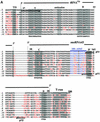

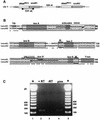
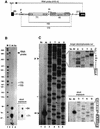
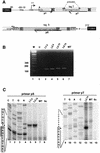
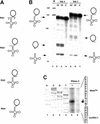
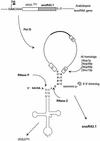
Similar articles
-
Identification of six new box C/D snoRNA gene clusters from rice.IUBMB Life. 2007 Oct;59(10):664-74. doi: 10.1080/15216540701589312. IUBMB Life. 2007. PMID: 17891605
-
Multiple snoRNA gene clusters from Arabidopsis.RNA. 2001 Dec;7(12):1817-32. RNA. 2001. PMID: 11780637 Free PMC article.
-
Processing of a dicistronic small nucleolar RNA precursor by the RNA endonuclease Rnt1.EMBO J. 1998 Jul 1;17(13):3726-37. doi: 10.1093/emboj/17.13.3726. EMBO J. 1998. PMID: 9649442 Free PMC article.
-
Eukaryotic snoRNAs: a paradigm for gene expression flexibility.Genomics. 2009 Aug;94(2):83-8. doi: 10.1016/j.ygeno.2009.05.002. Epub 2009 May 13. Genomics. 2009. PMID: 19446021 Review.
-
Non-coding snoRNA host genes in Drosophila: expression strategies for modification guide snoRNAs.Eur J Cell Biol. 2001 Feb;80(2):119-25. doi: 10.1078/0171-9335-00150. Eur J Cell Biol. 2001. PMID: 11302516 Review.
Cited by
-
Arabidopsis DXO1 links RNA turnover and chloroplast function independently of its enzymatic activity.Nucleic Acids Res. 2019 May 21;47(9):4751-4764. doi: 10.1093/nar/gkz100. Nucleic Acids Res. 2019. PMID: 30949699 Free PMC article.
-
Arabidopsis encodes four tRNase Z enzymes.Plant Physiol. 2009 Jul;150(3):1494-502. doi: 10.1104/pp.109.137950. Epub 2009 May 1. Plant Physiol. 2009. PMID: 19411372 Free PMC article.
-
Gene organization and sequence analyses of transfer RNA genes in Trypanosomatid parasites.BMC Genomics. 2009 May 18;10:232. doi: 10.1186/1471-2164-10-232. BMC Genomics. 2009. PMID: 19450263 Free PMC article.
-
Integral nuclear pore proteins bind to Pol III-transcribed genes and are required for Pol III transcript processing in C. elegans.Mol Cell. 2013 Sep 26;51(6):840-9. doi: 10.1016/j.molcel.2013.08.001. Epub 2013 Sep 5. Mol Cell. 2013. PMID: 24011592 Free PMC article.
-
Profiling Caenorhabditis elegans non-coding RNA expression with a combined microarray.Nucleic Acids Res. 2006 May 31;34(10):2976-83. doi: 10.1093/nar/gkl371. Print 2006. Nucleic Acids Res. 2006. PMID: 16738136 Free PMC article.
References
-
- Akama K. and Kashihara,M. (1996) Plant nuclear tRNA(Met) genes are ubiquitously interrupted by introns. Plant Mol. Biol., 32, 427–434. - PubMed
-
- Bachellerie J.P. and Cavaillé,J. (1998) Small nucleolar RNAs guide the ribose methylation of eukaryotic rRNAs. In Grosjean,H. and Benne,R. (eds), Modification and Editing of RNA. ASM Press, Washington, DC, pp. 255–272.
-
- Barneche F., Steinmetz,F. and Echeverria,M. (2000) Fibrillarin genes encode both a conserved nucleolar protein and a novel small nucleolar RNA involved in ribosomal RNA methylation in Arabidopsis thaliana. J. Biol. Chem., 275, 27212–27220. - PubMed
Publication types
MeSH terms
Substances
LinkOut - more resources
Full Text Sources
Other Literature Sources
Miscellaneous

